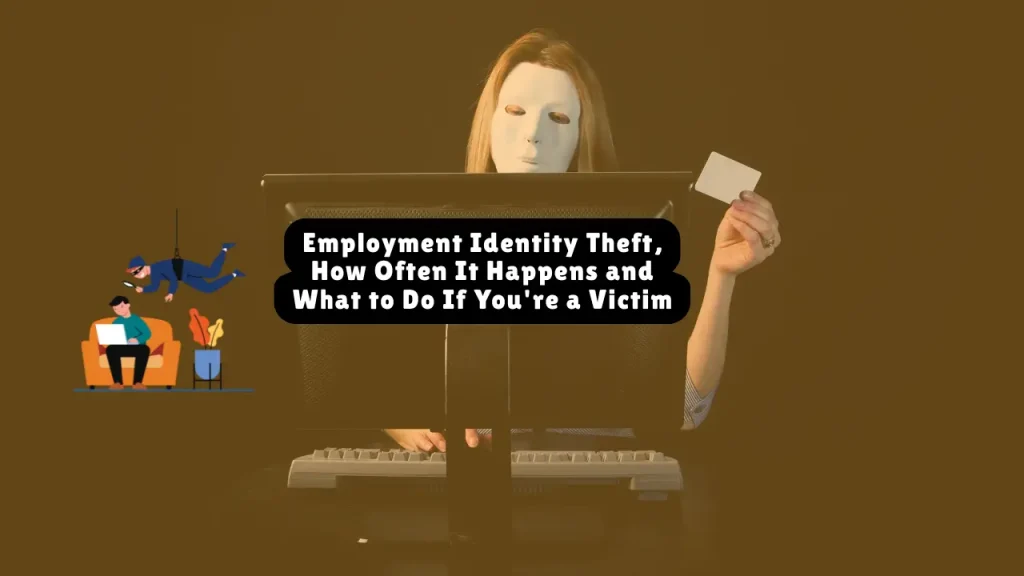Employment Identity Theft, How Often It Happens and What to Do If You’re a Victim
Employment identity theft is a growing and underreported crime in the United States, affecting tens of thousands each year. Unlike financial identity theft, this form involves criminals using stolen identities—often Social Security Numbers (SSNs)—to gain employment, bypass background checks, or evade legal restrictions.
In 2025, this form of fraud has emerged as one of the fastest-growing identity theft categories, and its impact can be long-lasting. Victims frequently discover the theft only after IRS audits, wage discrepancies, or Social Security problems surface. Here’s a detailed look at how often employment identity theft occurs, why it’s increasing, and the exact steps to take if you’ve been modified.
Table of Contents
How Common Is Employment Identity Theft in 2025?
Reported Cases and Real Numbers
According to recent reports:
- Over 37,000 confirmed cases of employment identity theft were reported in 2024–2025.
- It now ranks as the 8th most common identity theft type among 30 major fraud categories.
However, these numbers barely scratch the surface. Identity theft experts estimate that actual figures may be three to five times higher, primarily due to:
- Victims only discovering fraud during tax season.
- Misreporting or misclassifying the crime as generic identity theft.
Identity Theft Types by Frequency (2025)
| Type | % of Total Cases | Key Triggers |
| Synthetic Identity Fraud | 30% | AI-generated fake personas |
| Government Benefits Fraud | 24% | Pandemic-related relief scams |
| Credit Card Fraud | 18% | Phishing, skimming, credential leaks |
| Employment ID Theft | 9% | IRS inconsistencies, stolen SSNs |
| Medical Identity Theft | 7% | Stolen health insurance cards |
Why Employment Identity Theft Is Rising Rapidly
Common Motivations Behind the Crime
Criminals exploit stolen personal data for jobs in order to:
- Bypass citizenship or immigration checks, especially if undocumented.
- Hide a criminal record or poor employment history.
- Avoid failing background checks due to terminations, bankruptcies, or past fraud.
System Weaknesses Enabling the Crime
- SSN-based hiring checks: Over 90% of U.S. employers still rely exclusively on SSNs for employment verification (I-9), with little to no biometric validation.
- IRS processing lags: Once flagged for fraud, it takes 52+ days on average for the IRS to validate a taxpayer’s identity.
- Dark web exposure: More than 53 billion identity records are circulating online, and SSNs can sell for as little as $1–$15.
Related article: Business Identity Theft, How Big Is the Threat and What Can Be Done?
Who Is Most at Risk?
High-Risk Groups Include:
- Immigrants: 10% of reported victims are immigrants unfamiliar with U.S. tax and employment laws.
- Seniors (60+): Often targeted due to linked benefit fraud (e.g., Social Security).
- Urban professionals (ages 30–39): A growing segment due to the volume of personal data they share online and in job applications.
How to Tell If You’re a Victim
Most victims of employment identity theft only find out when:
- The IRS sends a notice about unreported income or duplicate SSNs.
- They receive W-2s from unknown employers.
- Their Social Security earnings record includes unfamiliar jobs.

What to Do Immediately If You’re a Victim
1. Report the Fraud to the IRS
- File IRS Form 14039 (Identity Theft Affidavit).
- Include it with your next tax return if you’re already filing late due to identity theft.
- Call the IRS Identity Protection Specialized Unit at 800-908-4490.
2. Contact the Credit Bureaus
Place a fraud alert or credit freeze on your credit file:
- Equifax: 800-525-6285
- Experian: 888-397-3742
- TransUnion: 800-680-7289
Fraud alerts last 1 year (renewable), and freezes prevent new credit from being opened in your name.
3. Check Your Earnings with the Social Security Administration
- Request a Social Security Statement to verify reported earnings.
- Report errors directly to the SSA to prevent benefit issues later.
4. File a Police Report
- Especially helpful if an employer mistakenly holds you accountable or if you’re denied benefits.
5. Notify the FTC
- Report the theft at IdentityTheft.gov.
- This creates a recovery plan and generates the documents you’ll need when disputing accounts or employment records.
How to Prevent Employment Identity Theft
- Limit who sees your SSN: Avoid sharing it unless required by law (e.g., tax forms, government filings).
- Shred sensitive documents before discarding.
- Use identity monitoring services that alert you to new employment records or credit activity.
- Secure your digital presence: Use two-factor authentication and avoid oversharing personal info online.
Final Thoughts: Employment Identity Theft Is a Long-Term Threat
Unlike a stolen credit card that can be cancelled and reissued, employment identity theft can contaminate your records for years. From tax audits to incorrect Social Security calculations, the consequences are often long-lasting.
As of 2025, this problem continues to grow due to weak verification systems and the sheer volume of data leaks. If you suspect you’re a victim—or want to avoid becoming one—act quickly, stay vigilant, and secure your identity across both digital and physical fronts.
About the Author

Sarah Klein, JD, is a former consumer rights attorney who spent years helping clients with issues like unfair billing, product disputes, and debt collection practices. At All About Lawyer, she simplifies consumer protection laws so readers can defend their rights and resolve problems with confidence.
Read more about Sarah
